My involvement with Homeworld Remastered can be distilled down to 1.63GB of data, containing 7679 files in 1156 folders. That represents the audio assets for both Homeworld and Homeworld 2 and what was released to Steam on February 25, 2015 as part of the Homeworld Remastered Collection. This audio data also represents what will face many game developers who want to take a classic title from “back in the day” and bring it into the modern era.
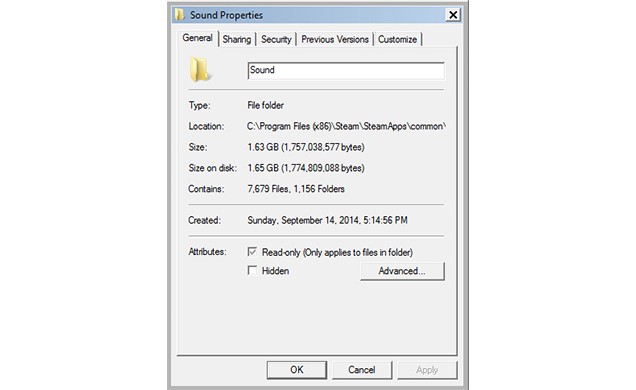
These are the details for the audio assets contained in the newly released Homeworld Remastered Collection. Some of these 7679 files were up to 15 years old and stored on a wide range of media devices, some of which had gone obsolete. These included Jazz and Zip Drives, Hard Drives and DAT tapes.
My involvement with Homeworld goes back to Oct 1998. That was when I started the Vancouver-based audio facility, Studio X Labs, as a result of getting the contract for audio production on Homeworld from Relic Entertainment.
In early 1999, Studio X Labs was still literally being built while I was working on Homeworld. The building of our recording room was finished the night before we started the Homeworld voice recording sessions.
The very first voice recording done at Studio X Labs was with Campbell Lane, where he recorded the Narrator and Bentusai parts that would end up shipping with the first game. The success of the first Homeworld title and the positive response to the game’s music and audio design led to a series of contracts with Relic Entertainment and Barking Dog Studios that would more or less have me functioning as audio director/composer/sound designer/audio integrator for Homeworld, Homeworld: Cataclysm, and Homeworld 2.
This period for Homeworld-related projects lasted from Oct 1998 to September 2003, with the finishing of Homeworld 2’s production. Since all of the music, sound design, and speech recordings for all 3 titles were produced at Studio X Labs during this period, it put me in a unique position with anyone wanting to revisit those titles.
New Beginnings
In April of 2013, when Gearbox became the new owners of Homeworld, Gearbox received the “retail” version of the audio assets that, in the case of Homeworld, had low-quality 1999-era MP3 audio compression on all the speech, music and sound design.
The retail speech files were 11kHz and compressed further with a proprietary Relic Entertainment codec called FDA (Frequency Domain Audio). This was so the speech files (and all other audio) could fit onto a 680 MB CD-ROM along with the rest of the game. It was pretty clear that whatever I had in the archives would be crucial for a revisiting the Homeworld series.
In July 2013, Gearbox came to Vancouver to meet with Blackbird Entertainment about their soon-to-be Homeworld Shipbreakers project. As part of that visit, Gearbox planned to come to Studio X Labs in order to meet and talk about Homeworld audio and what was in the Studio X Labs’ data archives.
The Homeworld audio was spread out over DAT tapes, old hard drives, CD-ROMs and DVD-ROMs, some of which were 14 years old, so their condition was uncertain. Here is what I found:
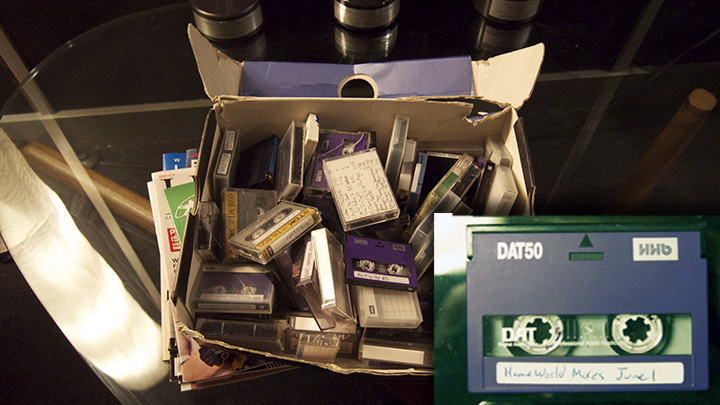
The original soundtrack mixes for Homeworld existed on a DAT tape which sat in the above shoe box for 14 years before being used again in the Homeworld Remastered Collection. The Homeworld music survived, uncorrupted, even though it sat in storage all that time. The insert is the actual DAT tape that contained the original mixes.
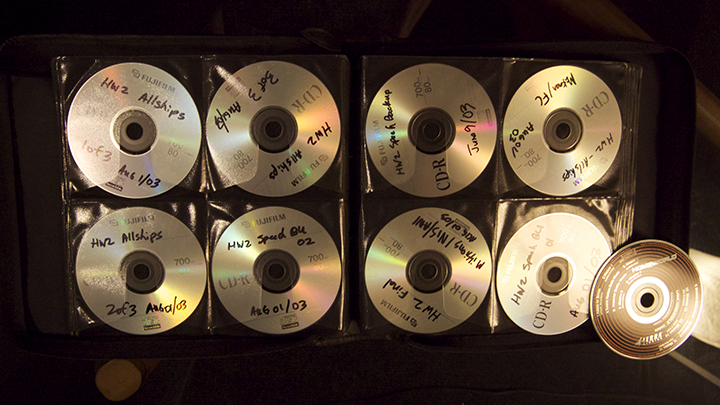
These CD-ROMs are the speech backup recordings for all of Homeworld 2 and my original 1999 GOTY soundtrack release of Homeworld. By 2003, Studio X Labs was recording using a Protools 6 Mac-based rig, so the original voice session recordings were backed up as Protools data sessions on CD-ROM. For Homeworld 2 Remastered, we re-recorded Heidi Ernest for Fleet Command and Michael Sunczyk for Fleet Intel. It was a nice conclusion to have both HW and HW2’s main characters finally be the same people!
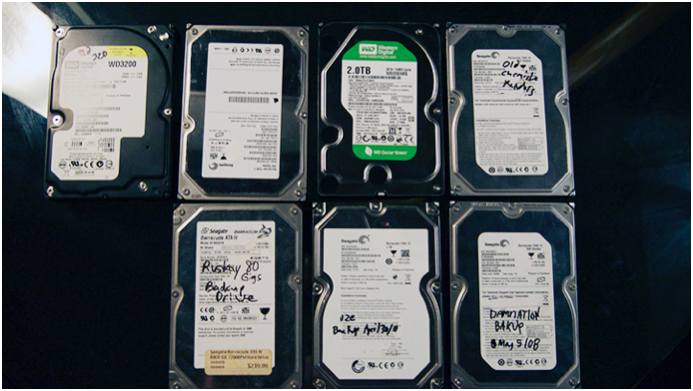
Homeworld 2’s soundtrack was comprised of Protools 6 sessions that had moved around various backup drives over the years. As hard drive formats became obsolete, I would occasionally migrate the Homeworld 2 music sessions to an updated drive format just as insurance against losing the material to old drive failure. Some of these backup-drives contained whole versions of SFX source data for the games as well. Piecing together the sound design banks required stitching together various data sources and doing match prints against the “retail-release” FDA versions to confirm a source match.
Remastering a Classic
The first step in remastering Homeworld‘s audio was to rebuild the existing “retail-release” FDA compressed audio banks with uncompressed source material. This would involve replacing the 7,679 “retail-release” files with full fidelity uncompressed versions. It would have been an impossible task if done manually, but Gearbox programmer Dave Eaton developed an audio fingerprinting utility that allowed us to comb through thousands of file directories looking for waveform matches.
As Dave explains:
We had a HUGE volume of sounds from before and after (aka raw and compressed/baked for in-game). I wanted to speed the process of determining what we had in either data set that we didn’t have in the other (aka sound X in the retail copy had no raw version, or we had extra raw sounds for baked asset Y). I ended up using a slew of different ideas about ‘audio fingerprinting’ — all run on top of a system that stored a fingerprint for each sound as-is (raw or decompressed to raw) — and also as ‘would be’ (raw compressed to match retail bake). With this huge database of fingerprints built for each set of data we had (often spread all over the place) — it became possible to not just generate reports on extra/missing files — but also use the relative path matches to rapidly copy and rename files from one set to another over and over. It greatly sped some of the early heavy lifting and delivered “clean” uncompressed versions of Data Source which would then could be worked on in relation to the new in-game mix.
This period of the remastering process dealt with archival issues around the data and at times, it did feel like a restoration project. Time would be spent trying to fill in areas of the data set that were missing. Other data would just be ready to go and basically be plug and play. Through this process of back-checking and rebuilding the uncompressed source, the entire sound presentations of both games were stitched back together and then cross-checked against the classic versions. It was a good thing that so many people had posted videos of walkthroughs of classic Homeworld missions, as I was continually referencing those to make sure we were creating the same experience as in the classic version.
The slow process of verifying data and testing it in-game allowed for a long period where I was able to play the game and just listen to raw source audio going in. There is a balance of elements in the Homeworld games that, if you get them right, the visuals and audio take on this kind of magical quality; a kaleidoscope of light, sound and destruction.
I spent some time reconnecting with what I had remembered about the tools. Since the entire mix system for both titles were using the same original Relic Audio Tool (aka RAT), it was the ultimate déjà vu working with the same tool and looking at the same settings, as I left them 12 years earlier. It took a little time for me to fully remember the ins and outs of RAT but I was soon swapping files and updating mixes in my Steam build.
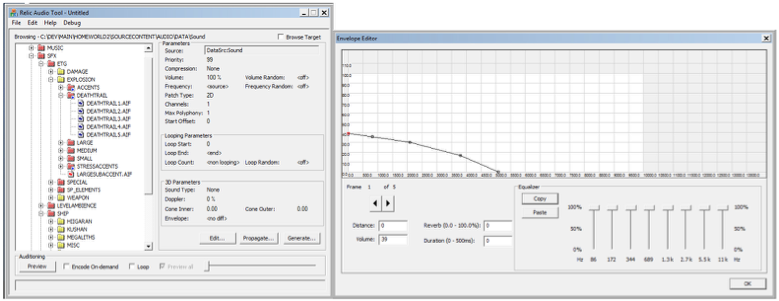
These two windows show the Relic Audio Tool with one of its editors. Both HW and HW2’s audio design and mix were done with a tool that hadn’t changed since 2003. When I started on the audio design and the full fidelity source audio was updated in the game, I was pleasantly surprised at how well RAT still worked. It would take many hours of updating speech, music, and sound design to bring the overall audio to match the quality of the visuals. The trick was to recreate and enhance the existing audio assets up to the level of the stunning upgrades to the visuals.
Since my audio mix was being tested within the daily Steam build, I was able to experience the development of visual quality directly. It was an amazing experience when shadows and visual effects started to come on-line. It made me continually reassess the game’s audio balance against this improving visual benchmark.
For Homeworld 1, since the music only existed as stereo mixes, I would add more layers of synth bass or pads to widen and deepen the overall mix. All additional elements added to music and sound design were meant to create a wide cinematic feel without altering the track’s original character.

Over the course of the production, the look of the game changed dramatically as new visual effects, high-definition models, and lighting were turned on. On the left is a screenshot of NIS01 in Homeworld 1 early in development. Its model is not complete, the lights aren’t turned on, and lighting and shadows are missing. On the right is a screenshot close to launch with all visual effects working. It became a powerful experience when mixing the audio to the visuals when they were close to being fully realised.
Homecoming
For me, Homeworld Remastered was a simultaneous trip into the past and future. The nature of audio production is that you are continually saving time — little crafted moments of time that contain, for example, a person speaking, a sound effect, or a musician playing their instrument.
The innate character of a person’s phrasing or a musical flourish is something that is nearly impossible to recreate. The audio data stored at Studio X Labs was really a time capsule. It allowed me to go directly back in time to when we first made these games. Since the audience’s memory of the games is intrinsically linked to how the game’s audio made them feel, it was so fortunate to have all the archived audio.
For other developers who want to go down the “Remastering” path, I know now how crucial it is to secure as much of the original audio as possible. I shudder to think what it would have been like if I had to recreate from scratch any of the music, speech or sound design. Homeworld Remastered is not without its issues and bugs, but every game will have issues and bugs. The real challenge with Homeworld Remastered‘s audio production was recapturing that intangible “magic” that the audience remembered and expected to re-experience.
Homeworld Remastered has also finally given me the opportunity to release both the Homeworld and Homeworld 2 soundtracks completely remixed and formatted for an album listening experience. It is a full-circle resolution to finally put closure on this music that has been in limbo for so many years.
As someone who has been producing audio for video games since 1994 and the days of Sega Genesis, I can only say that I feel very fortunate to have been given the opportunity to take a second run at the audio on Homeworld and Homeworld 2. These titles represent to me the most creatively satisfying material I’ve produced in the industry, and I am so pleased that Homeworld Remastered’s reception has been overwhelmingly positive by press and the its audience.
Paul Ruskay is a composer and sound designer who works from Studio X Labs, an audio post-production studio based in Vancouver, Canada, that he founded on February 1, 1999.
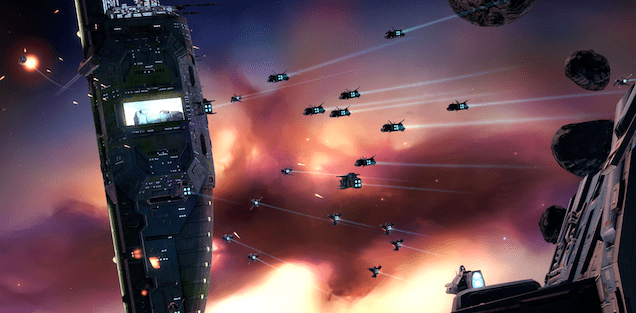
Comments
8 responses to “How We Overhauled The Homeworld Soundtrack For New Audiences”
Thank you for this insight, being a backup nazi I find it shocking that large game companies don’t keep proper backups of stuff, nice to see you had the foresight and care to do the sound work justice 🙂
Very interesting. Thanks for the write-up. 🙂
Anyone else mistake that space station in the first picture as a giant cheap digital watch from the early 90’s?
The music in the Homeworld series is probably one of the most moving and memorable soundtracks in video-games to date. A work of art that injected so much atmosphere, foreboding and feelings of loneliness into a game that was far ahead of its time.
Thank you Paul for your work on this game’s music, both then and now. It will be remembered for a long, long time.
I’m kind of annoyed…..
They clearly went to great length and effort to truely recreate the sound and audio of the series. But Homeworld RM ended up being built off the Homeworld 2 engine and lacks many of the elements that made it so great.
To be fair, the music was done extremely well and this article shows why, well done and great read
Yeah, resource-management and balancing in particular took a real hit in Homeworld remastered thanks to the HW2 engine. I was really disappointed by that.
1) They felt the need to do it for balancing since they wanted to make multiplayer for all the races possible.
2) They probably felt that the old system in place in HW1 with fuel management and all that too far removed from modern RTses. In the end, the product still has to appeal to current gamers and sell. They had to take a punt one way or the other…
Then these are things that needed to be talked about before its release, rather than touting how it was a visual change and how the games would retain the integrity of the original.
The idea that the game wouldn’t appeal to modern gamers is a cop out, the majority of the community who followed and supported the RM were fans of the original. Others knew of the games reputation and wanted to experience it since it no longer ran on newer PC’s
Fuel could have been removed without changing much, simple mods existed for the original HW that did just that. All other removed and broken features aren’t strange or outdated, formations for example were left in, they just don’t work or have the original purposed effects, so I will have to call nonsense on the appealing to modern gamers nonsense.
Don’t even get me started on the “balance” of MP, there is none, so that seems like a cop out too.